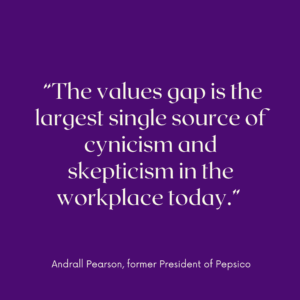Are you really walking the talk?
Walk the talk. It’s a familiar phrase in leadership conferences, manager meetings, and pep talks. There is even accredited training on this very subject. The phrase is, so familiar, that many of us forget just how powerful the message is when our actions do not reflect the message that we are communicating.
Let’s take a moment to reflect on new employees’ first days. Many new employees will attend a company induction day. The history of the company will be told, for some policy and procedure will be covered, others may also include a customer service module. Let’s not forget the mandatory Health and Safety and other training mandated by legislation.
For many companies, sharing of company values will be a part of induction day training. There is a good reason for its inclusion. It sets the scene of expected behaviours, and it creates a common understanding and sets the scene as to what to expect in the workplace. You could even say it’s a foundation for the companies’ culture. It’s good business practise. It makes sense, right?
In the early days of employment, it’s the honeymoon period. People are friendly; new employees are excited about their prospects and opportunities. For some, the honeymoon period is long. For others, it ends when they see that the company values are more rhetoric than being applied by their leaders and colleagues.
It smacks of double standards. ‘Do as I say, not as I do.’ ‘I expect this of you, but not of myself.’ It can occur for several reasons, rapid growth, lack of accountability in ‘calling out’ when behaviour is not in line with company values, rapid promotion, distance from the front line for executives or senior management members, to a sense of entitlement. Let’s not forget the ‘cheese factor’ (Fish! Philiosphy anyone?) of values that are stated but not lived.
Let’s take a moment to view it from the eyes of an employee.
- The business is growing, fast. There are more employees than employee desks. The lease still has a couple of years to run, breaking the lease isn’t an option. There is much discussion at senior management and executive-level about implementing a hot-desking policy. No one has taken on the action. It doesn’t impact the executive- they all have their own office. Existing employees have allocated desks. New employees are expected to ‘make do,’ despite there not being an allocated hot desk policy or desks. Regular employees and visiting employees from interstate or overseas spend most of their morning trying to locate a place to work, often resulting in working offsite. The message received by the newer employees is that they are not valued in the same way as existing employees or the executive team. Many new employees decide within the first 10 days of employment regarding if they will be long term employees. This company executive have inadvertently decided to increase their recruitment costs, and decrease employee engagement, by choosing not to take action.
- Kieran works in the State office. The location is known for being hot all year round. It becomes apparent despite the values of equality, democracy, and team work, and there is a clear difference depending on your seniority in the organisation. The Senior Management team has car parks undercover with their name on them, close to the front door. The rest of the office access to an uncovered car park – where there are fewer car parks than those who drive to work. The location of the state office is not public transport friendly. What message is being sent to the employees about the real value of the company values?
- Andy’s boss regularly works from home or takes leave without pay. It sometimes seems that they are away more than they are at work. When Andy asks to come in late due to attending a child’s school assembly, his boss says ‘apply for half day leave’. Despite the company promoting flexible working policy and his boss actively enjoying the benefit- they make it hard for Andy to do so, despite his role being able to be conducted remotely. What is the impact on Andy? Andy feels that there is a clear double standard. The impact is ongoing, his sense of agency and feeling respected and appreciated for what he does. For Andy and his peers, it corrodes staff morale and staff respect for the boss (there’s none)
- Louise is a nurse. She regularly works shift work. The hospital that she works at has many posters stating the importance of respect and safety of their employees. Recently there has been a spate of incidents and attacks on workers when walking to their cars after their shift ends. Overflow car parking is a 15-minute walk down the road. Executives and Doctors have their own dedicated car parks. The executive car park is closest to the hospital and has underground lift access. The executives tend to work core business hours. Some nurse and orderly shifts finish at 01.30 are in the morning. Despite the multiple attacks, there have not been any changes to increase the safety of workers finishing at this time. Meanwhile, the executive car is empty. Safety of employees is now seen as lip service. Turn over increases each time there is an incident.
Each of these examples is based on real experiences and workplaces. Would you want to work in these environments? One of the most challenging things a leader must do is to model the behaviour they ask of their employees.
However, it’s necessary. If employees don’t see their leaders stand up and lead by example, employees will feel less engaged—and be less willing to do their best work. “Do as I say, not as I do” might once have worked for both parents and stern bosses, but time has moved on from “Command and Control” Leadership style.
‘Walking the talk’ means doing what you say you will; transforming the words behind your values, into tangible actions and most of all driving accountability to ensure that the values are modeled and actioned.
As the age old saying goes, ‘actions speak louder than words’. Employees notice when the message received by their leaders is not followed up by action. Have you ever in a group conference call and witnessed the body language of attendees, when their past experience indicates that these new actions will not be follow up or applied?
Critically, it’s important that actions are followed through at leadership in all levels of the business. No one likes to feel that they are adhering or being held to account and seeing others that are not. Unless the behaviours employees see exhibited align with what the leaders deem necessary, corporate values will have little to no positive impact.
Lack of actions or double standards quickly become company folklore and activity becomes part of the company culture. Once the credibility of a leader or executive team has been diminished, it’s hard to turn around.
Review your communication, written, verbal and your actions.
So, what can you do?
To “walk the talk’ communication is key. Engage in authentic conversations. Are you unwittingly sending a message that doesn’t reflect with what is being said or requested?
One way to do this is to check your willingness to:
- Model behaviours
- Define what acceptable behaviours ‘look like’
- Attend training asked of others in the organisation that is values or behaviour driven.
- Apply behaviours in all aspects of roles and actions.
- Call the behaviour of others – both the good, and the not so good.
If you can’t genuinely do this – it may well be time to review if your current organisation and role is the right one for you and the organisation.
Make others hold you accountable.
Leaders may guide teams, but leaders are also nothing without their teams. Not only will this hold you accountable for your actions, but it can also help in the development of your leadership capability and most importantly being open to receiving feedback from your team.
Be consistent
Every one of your employees must be expected to behave in line with the organisation’s values, no matter who they are or the role they play. Making exceptions (‘That’s ok, Darren is like that’. Or “Everyone knows that I am a cranky person. No one takes what I say seriously…” both undermines your company’s values, and your commitment to upholding them. Even the most senior leader or highest revenue earner must be held accountable, or confidence in your commitment to your values will be eroded. If people don’t believe that you mean what you say, they will disengage and stop caring also.
Each of us has our own war stories from being on the receiving end of double standards from a manager, or environment that pays lip service to company values. We are human, and we make mistakes. However, we can also learn.
New habits can be formed. It starts with reflection. What message are you sending to your team or peers? What actions will you take to walk the talk?
Interested in Supervisor or effective team training?
Training Materials and courseware. Powerful tools to supercharge the training of your employees.
https://www.facilitatedtraining.com/store/
✅ Facilitated Training: https://www.instagram.com/facilitated_training
✅ Facilitated Training FACEBOOK: https://www.facebook.com/pg/facilitatedtraining/posts
✅ Facilitated Training WEBSITE: https://www.facilitatedtraining.com
✅Facilitated Training PINTREST https://www.pinterest.com/coll_condon/pins/ (facilitated training)
✅ Facilitated Training BLOG https://www.facilitatedtraining.com/articles/
💌EMAIL ALL ENQUIRIES TO: hello@facilitatedtraining.com
#learningtips #learnfast #corporatetraininingmaterials #editabletraining #offtheshelftraining #facilitatedtraining #humanresources #humanresourcesmanagement #softskillstraining #learninganddevelopment #training #leadership #managementtraining #behaviouraltraining #professionaldevelopment #personaldevelopment #selfdevelopment #developmentwork #skilldevelopment #developmentteam #instructionaldesign #energisers #problemsolving #softskillstraining #learninganddevelopment #editableresources #humanresources #professionaldevelopment #editablecourseware #facilitatedtraining #training #trainingtips #courseware #trainingmaterials #trainingmaterialsprep #trainingmaterialsdeveloped #trainingmaterials


